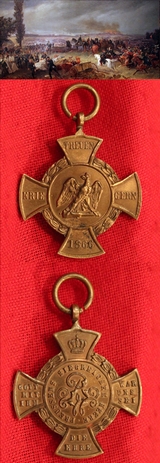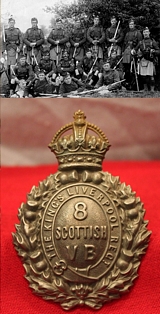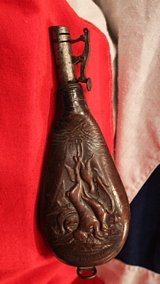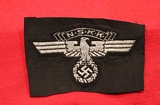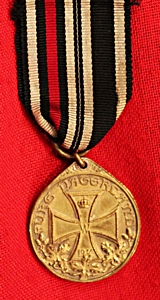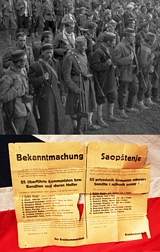A 1930's Essex Regt. Silver Officers Cap Badge
Essex Regiment Officer?s 1935 silver cap badge. Fine example. Within an oak wreath surmounted by a Sphinx resting on ?Egypt? tablet Castle and Key of Gibraltar, across the base a scroll inscribed ?The Essex Regt?. The Essex Regiment was a line infantry regiment of the British Army in existence from 1881 to 1958, and served in many conflicts such as the Second Boer War and both World War I and World War II, serving with distinction in all three. The regiment was formed in 1881 under the Childers Reforms by the amalgamation of the 44th (East Essex) Regiment of Foot and the 56th (West Essex) Regiment of Foot. read more
120.00 GBP
The Prussian v Austria War Medal 1866, Made From Captured Cannon
Bronze cross patt?e alis?e, a laurel wreath between the arms, with ribbed loop for ribbon suspension; the face with a circular central medallion bearing the cipher ?WR? for King Wilhelm I, circumscribed ?PREUSSENS SIEGREICHEM HEERE? (Prussia?s victorious armies), the Prussian crown on the upper arm of the cross, the left, right and lower arms inscribed ?GOTT WAR MIT UNS. IHM SEI DIE EHRE? (God was with us. To Him be the glory); the reverse with a circular central medallion bearing the crowned Prussian royal eagle perched on a cannon, the upper, left, right and lower arms inscribed ?TREUEN?, KRIE-?, ?GERN?, ?1866? respectively; some slight age oxidisation and wear to gilding; on replaced correct ribbon. The medal was instituted by King Wilhelm I on 20 September 1866 following the victorious war against Austria and its German allies. The medal was cast from the bronze of captured Austrian cannon. The Austro-Prussian War or Seven Weeks' War (also known as the Unification War, Prussian?German War, German Civil War, War of 1866, as well as Brothers War or Fraternal War, and in Germany as German War) was a war fought in 1866 between the German Confederation ("Deutscher Bund") under the leadership of the Austrian Empire ("Kaisertum ?sterreich") and its German allies on one side and the Kingdom of Prussia with its German allies and Italy on the other, that resulted in Prussian dominance over the German states. In the Italian unification process, this is called the Third Independence War.
The major result of the war was a shift in power among the German states away from Austrian and towards Prussian hegemony, and impetus towards the unification of all of the northern German states in a Kleindeutsches Reich that excluded the German Austria. It saw the abolition of the German Confederation and its partial replacement by a North German Confederation ("Norddeutscher Bund") that excluded Austria and the other South German states. The war also resulted in the Italian annexation of the Austrian province of Venetia. read more
85.00 GBP
Prussian Danish War Medal, 1864, Made From Captured Guns
Prussian, Denmark Campaign Medal. 1864 - Engraved Edge. Since the London accords of 1852 the duchies of Schleswig, Holstein and Lauenburg were attached by personal union to Denmark. Following the new constitution of 1863 Denmark integrated these areas into the state which caused a protest from the Deutsche Bund. After a resolution of the German Bundestag the German states send "Execution" troops into the duchies which belonged to the German Federation (Holstein and Lauenburg) under the command of Generalleutnant Heinrich von Hake formed by a Saxon brigade under Generalmajor von Schimpff as the operational-force, a Hanoverian brigade under Generalleutnant Gebser as a supporting force and a Prussian and an Austrian brigade in reserve. The Austrians took part in this Bundesexekutionscorps by sending a brigade under the command of Generalmajor Leopold Graf Gondrecourt. But in addition to this, the two German major powers, Prussia and Austria, decided to declare war on Denmark and sent an army consisting of three corps under the command of the Prussian Feldmarschall Friedrich Graf Wrangel, whose Chief of the General staff was Generalleutnant Eduard Vogel von Falkenstein. The 1st corps was commanded by the Prussian Prince Friedrich Karl, the 2nd corps by Feldmarschall-Leutnant Ludwig Freiherr von Gablenz and the 3rd corps by Generalleutnant von der M?lbe. The 2nd (Austrian) corps was formed by the 6th army corps, enlarged by a cavalry brigade and 2 heavy batteries. Additionally Graf Gondrecourt's brigade also joined the 2nd corps after leaving the surprised federal troops. On the 1st of February 1864 58,000 Prussian and 21.000 Austrian soldiers crossed the Eider and commenced operations against the Danish land forces. On the 2nd and 6th of February the Austrians were victorious at Vejle and Oeversee whilst the Prussians were successful at the D?ppeler Schanzen near Sondersburg on the 18th of April 1864. On the 9th of May a naval squadron commanded by Contre-Admiral Wilhelm von Tegetthoff successfully engaged superior Danish forces near the island of Helgoland. The Danish forces retreated to Northern J?tland and the islands of Alsen and F?nen and an armistice for 6 weeks was agreed for a new peace treaty of London. After the failure of these negotiations the hostilities again resumed on the 25th of June 1864 and the Austrian forces reached the Northern part of J?tland and finally Cape Skagen. The Danish Captain Hammer, who had caused the most trouble for the Austro-Prussian naval forces was captured between the islands of F?hr and Sylt and a new armistice was implemented on the 20th of July 1864 which finally lead to the peace agreement of Vienna on the 30th of October 1864. Denmark was forced to hand over the contested duchies to Prussia and Austria. However disagreement over the administration of these duchies soon became one of the primary reasons, especially promoted by the Prussian prime minister Otto von Bismarck, for the coming conflict between the two German major powers in the war of 1866. Franz Joseph I, Kaiser of Austria, and Wilhelm I, King of Prussia, agreed to institute a commemorative medal for their successful army. The great number of captured guns, especially from the fortress of Frederica, made it possible to decide that the medals should be minted from the brass of the enemy's guns. Kaiser Franz Joseph signed the institution of the medal on the 10th of November 1864 and the regulations (Statuten) dated the 11th of November and both were published in the Armeeverordnungsblatt on the 20th of November 1864. The official name was: "Erinnerungs-Medaille an den Feldzug 1864 gegen D?nemark" (commemorative medal for the 1864 campaign against Denmark) Along the rim of the medal the words: "AUS EROBERTEM GESCHUETZ" (from captured guns) read more
85.00 GBP
8th Scottish Volunteer Battalion Helmet Plate the Kings Liverpool Regiment,
The pre-war territorial Battalions of The King's Liverpool Regiment will also show that the social class within the city was still divided. The King'sLiverpool had six territorial battalions within the city, 5th, 6th, 7th, 8th, 9th, and 10th. The 6th catered for the middle class, 5th, 7th and 9th for the respectable working class, while 8th ( Irish ) and 10th ( Scottish ) recruited men with links to the respected country. the King's Liverpool territorial regiments fought alongside one another many times in France and Belgium in WW1. The battalion was formed on 30th April 1900 when due to the Boer War, it became clear there was a need for men to volunteer their service. It was raised from the higher educated and professional young Scotsmen of city of Liverpool and named the 8th (Scottish) Volunteer Battalion, The King's (Liverpool Regiment). To join you paid an annual subscription of 10 shillings, and an entrance fee of ?2. The first Commanding Officer was Colonel C. Forbes Bell. read more
75.00 GBP
A 19th Century Leather Shot Flask By Renown Maker James Dixon and Son
Embossed leather relief design of hanging game. J Dixon & Sons (James Dixon & Sons) founded 1806 in Sheffield, was one of the major British manufacturers in the Industrial Revolution of the 19th century. They were well known as manufacturers of Pewterware, Electroplated Britannia metal Silverware and Electroplated nickel silver. Their products included hundreds of items for use in the kitchen (e.g. bowls, cutting-tools) and the dining room(e.g. tea services, cocktail shakers and mixers) as well as items like candlesticks for all rooms. They were a world leader in manufacturing shooting accessories through nineteenth century and exported powder flasks in large quantities to America, They were known as whistle makers, which like most of their products were of outstanding quality; they were one of the 4 great whistle makers, the others being W Dowler & Sons, J Stevens & Son & T Yates.
It was located first at Silver Street (1806), Cornish Place (1822) Sheffield . They were also famous for their sporting trophies. Two of the most well-known are the Hales Trophy commissioned in 1932 (sometimes called the Blue Riband) though this really refers to the pendant flown by the sailing ship currently holding the record for the fastest crossing of the Atlantic. The trophy was then held by the owners of that ship. The other great trophy is the one presented to the winner of the American Masters Golf tournament held annually in Augusta Georgia. This trophy is a scale model of the clubhouse made in 1959-60 and contains 453 troy ounces of silver. read more
120.00 GBP
A National Socialist Motor Corps Enlisted Man's Side Cap Eagle Badge
an eagle sitting, its talons gripping a wreath swastika below, with a ribbon banner above inscribed "NSKK", - read more
65.00 GBP
German WW1 Medal of the German Legion of Honour.
Deutsche Ehrendenkm?nze des Weltkrieges der Deutschen Ehrenlegion.
Awarded by the "Council of the Order" of the Union of Nationalist Soldiers to men or women who, during WWI and after dutifully served the Fatherland.
This bronze medal, either gilded or coppered. Noteworthy is the portayal of the winged Victory crowning a German soldier on the obverse. The reverse shows the Iron Cross 1st Class with oak leaves around the lower rim of the medal. Along the upper edge of the medal is the text "F?RS VATERLAND" (For the Fatherland) in Gothic lettering. The ribbon is formed with the then German national colours.
For frontline troops a combat emblem was created for attachment to the ribbon : a gilt oak leaf wreath with a sword across.
This medal was first proposed in the autumn of 1917 but it took till 1921 before the "Council of the Order", which was to effect the actual awarding, was formed. Recipients had to pay for their medal themselves and could, if they so wished, be entered in the German Legion of Honour. This organization was divided in "Ritterschaften" (knight groups) and its members could call themselves "Ritter der Deutschen Ehrenlegion" (Knight of the German Legion of Honour).
Early in the Nazi era, by a decree of 15 May 1934, awards like these were forbidden and the German Legion of Honour joined the Kyffh?user-Bund (the official veterans' organization) soon after. read more
75.00 GBP
A Nazi German Occupation WW2 Public Notice Wanted Poster 1944
Listing in two languages, German and East European [possibly Slovenian] 55 Communist Bandits and their helpers. Various torn areas but vital to be kept as a piece of unique WW2 history. Would be perfect framed for display. In the aftermath of Munich, Slovak politicians from the democratic parties (Republican Party of Farmers and Peasants, Czechoslovak Social Democratic Party, and Czechoslovak National Socialist Party) organized a resistance movement. Individual underground cells sprang up in towns and villages throughout Slovakia. A campaign of "whispering" propaganda was initiated to alert the acquiescent Slovak population to the true nature of the Tiso regime. The goal of the democratic resistance was the restoration of the Czechoslovak Republic, but with greater participation for Slovakia. In the spring of 1939, the "Zeta" headquarters was established in Bratislava to coordinate with the Czech resistance and to transmit intelligence information to the liberation movement abroad. Party Communists remaining in Slovakia formed the underground Communist of Slovakia (Komunisticka strana Slovenska--KSS) and until 1943 favored the creation of an independent "Soviet Slovakia."
The shortage of qualified personnel enabled resistance members to infiltrate all levels of the Tiso administration, where they promoted economic sabotage. Mutiny within the Slovak army (marshaled by the Axis powers for combat against Poland and, later, the Soviet Union) was encouraged and became commonplace. At Kremnica, on September 15, 1939, approximately 3,500 Slovak soldiers abandoned their transport train and marched into the city. Members of the underground Slovak Revolutionary Youth set fire to machinery in factories, emptied the fuel tanks of locomotives, and exploded munitions in warehouses. Slovak youth turned increasingly against the Tiso regime.
In his Christmas broadcast of 1942, Benes called for resistance groups in Slovakia to increase their activity in preparation for a seizure of power. The groups worked to unify their efforts. The following November, negotiations between democratic and communist resistance leaders culminated in the signing of the Christmas Agreement of 1943. The agreement called for the creation of the Slovak National Council to represent the political will of the Slovak nation. The Slovak National Council would act in concert with the Czechoslovak government and liberation movement abroad. The postwar Czechoslovak state would be democratic and organized on the basis of national equality. The Christmas Agreement provided also for a close association with the Soviet Union in foreign policy and military affairs. Benes endorsed the agreement on March 27, 1944.
The Allied powers agreed that Slovakia would be liberated by Soviet armies. In March 1944, with Benes's approval, the Slovak National Council authorized Lieutenant-Colonel Jan Golian to prepare for a national coup to be coordinated with the arrival of Soviet troops. Golian organized a secret military center at Banska Bystrica and created Slovak partisan units composed of escaped prisoners of war and army deserters. The Slovak National Uprising of August 29, however, was premature. The Soviet government, regarding the Slovak resistance as politically suspect, failed to inform the Slovaks of a change in Soviet strategy. Despite American efforts to assist the uprising, the German Wehrmacht occupied Slovakia, and Banska Bystrica fell on October 27. Nonetheless, local partisan warfare continued up to the liberation. read more
120.00 GBP



